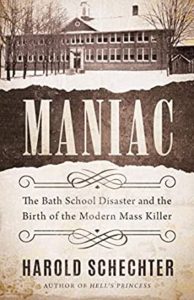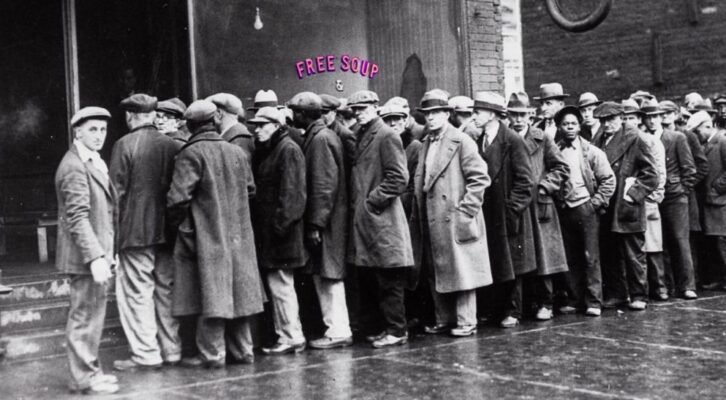As a historian of American crime, I spend an unhealthy amount of time poring over old newspapers—in archives, on microfilm, and, increasingly, online. While researching a book on Belle Gunness—the infamous “Lady Bluebeard” who slaughtered an indeterminate number of victims at her Indiana “murder farm” in the early twentieth century—I had occasion to consult the July 7, 1902, issue of the Fort Wayne Daily News.
Along with stories on a strike by twelve hundred railroad freight workers, a visit to the United States by the Crown Prince of Siam, a local man who survived a shark attack while swimming off a pier in Atlantic City, and an elderly “negress” who inherited four hundred acres of prime Kentucky farmland from her former mistress, the front page featured articles on one Peter Dempsey, who attempted to slay all seven members of a Montana family in a scheme to abduct their seventeen-year-old servant, a “quarter-breed Indian girl” with whom he had become “enamored”; another seventeen-year-old girl, Maude Bernice Fritz of Kokomo, Indiana, who, after allegedly being gang-raped by three high school acquaintances, went into the woods, soaked herself with kerosene, and set herself on fire; an adulterous pair from Knoxville, Tennessee, Howard Jenkins and Mrs. Agnes Fleming, who “conspired to murder Mrs. Fleming’s husband and Jenkins’ wife in order that they might marry themselves”; and the massive manhunt for the escaped “desperado” Harry Tracy, a kill-crazed Western badman said to make Jesse James seem like a Sunday school teacher by comparison.
What’s always striking to me about such dreary news items—and examples could be multiplied indefinitely—is not the sheer volume of appalling crimes that occurred on an everyday basis in a past many romanticize as a more halcyon age but, rather, how instantly even the most horrific were forgotten. Harry Tracy, it is true, remains a figure of some renown to aficionados of Wild West outlawry. Compared to such legends as the James boys, Butch Cassidy, and Billy the Kid, however, he has utterly faded from public memory.
The same phenomenon holds true today. In the early 2000s, until the exercise became too depressing even for me, I kept a file of clippings about appalling crimes that ran in the New York City tabloids for a day or so before vanishing forever from the media. Here’s a small sampling:
Girl kills sis over burger (New York Daily News, February 12, 2005);
Woman’s chopped-up body found in Bronx (New York Daily News, March 15, 2005);
Tot-hang dad gets 22 years (New York Post, March 22, 2005);
Monster guilty of ma & son murders (New York Post, May 28, 2005);
Teen mom throws baby to hungry dog (New York Daily News, March 6, 2001)
It’s no surprise that the dailies are filled with stories like these. At least since the 1830s, when the New York Herald ’s lip-smacking coverage of the Helen Jewett hatchet-murder set the template for tabloid sensationalism, newspaper publishers have recognized—and cashed in on—the popular appeal of grisly crime. However cynically expressed, the journalistic adage “If it bleeds, it leads” conveys a discomforting but undeniable truth: murder sells.
Of course, some murders sell better than others. The Herald ’s publisher, James Gordon Bennett, observed, “Men who have killed their wives, and committed other such everyday matters, have been condemned, executed, and are forgotten, but it takes a deed that has some of the sublime of horror about it to attract attention, rally eloquence, and set people crazy.”
The kind of all-too-common homicides that Bennett alluded to—husbands murdering wives (and vice versa), parents killing children (and vice versa), simmering disputes between neighbors that escalate into lethal acts of violence—might provide the public with a bit of morbid titillation. They are a tasty little snack for that primordial part of ourselves that philosopher William James called “the carnivore within.” But for a murder to really take hold of the communal imagination and exercise an enduring grip, something else is necessary.
Bennett called that something “the sublime of horror.” And it’s true that certain infamous American crimes feature atrocities straight out of a gothic horror story: cannibalism, necrophilia, sexual mutilation, and the like. But horrific violence isn’t enough to ensure that a crime will become an ongoing media sensation, let alone a permanent part of our cultural mythology.
Few recent crimes, for example, have been more nightmarish than the one that befell the family of Dr. William A. Petit Jr. On the night of July 23, 2007, Steven J. Hayes and his accomplice, Joshua Komisarjevsky—a pair of small-time hoodlums who had bonded at a halfway house for parolees—invaded the Petit home in the bucolic community of Cheshire, Connecticut. After savagely beating and then binding the fifty-year-old endocrinologist, they proceeded to terrorize and torture his family, raping his wife, Jennifer Hawke-Petit, and at least one of the couple’s two daughters. In the morning, they forced Hawke-Petit to go to the local bank and withdraw $15,000, after which they brought her back home, strangled her, doused the children—Hayley, seventeen, and Michaela, eleven—with gasoline, and set the house on fire. Only Dr. Petit managed to survive.
And yet—for all the attention the case received, including major coverage on network TV news—few people, apart from the most hard-core true-crime buffs (and, of course, those most affected by the tragedy), could tell you the names of the perpetrators. Within a startlingly short time, the appalling case had been all but forgotten.
By contrast, a far less horrific homicide (as such things go), the kidnap-murder of a fourteen-year-old boy in 1924, has entered into legend, and its perpetrators, Nathan Leopold and Richard Loeb, occupy the same position in the pantheon of American evildoers as Lizzie Borden, Charles Manson, and O. J. Simpson.
One of the most notorious crimes of James Gordon Bennett’s day is instructive in this regard. In September 1841, Samuel Adams, a prominent New York City printer, left his shop in lower Manhattan on a business errand and was never seen again. One week later, his decomposing corpse was discovered inside a packing crate stowed in a steamship’s cargo hold. The crate, addressed to a nonexistent recipient in New Orleans, was traced to its sender, John C. Colt, brother of the soon-to-be-legendary inventor of the revolving handgun and author of a standard accounting textbook that Adams had been hired to print.
According to Colt, Adams had come to his Broadway office on that fateful day to collect a debt. The two had argued over the amount. First insults, then blows were exchanged. When Adams grabbed him by the throat and started choking him, Colt reached for a shingle hammer lying on his desk and delivered a fatal blow to his assailant’s head.
From the moment of Colt’s arrest, the case became a nationwide sensation. It wasn’t the murder per se, however, that gripped the public.
Altercations between two hot-tempered men that end with one of them dead happen all the time and were even more commonplace in the rough-and-tumble days of 1840s America. What turned the Colt-Adams affair into one of the century’s most memorable crimes was a combination of ingredients: the prominence of the perpetrator; the mysterious disappearance of the victim; the bizarre method used to dispose of the corpse and the sheer grotesque horror of its discovery; the ensuing, highly suspenseful trial; and the wildly melodramatic denouement that saw Colt, on the morning of his scheduled execution, marry his longtime mistress in his jail cell, then stab himself to death with a smuggled-in penknife. In short, it was a crime with fascinating, vivid characters, an intriguing setting, and a gripping plot full of mystery, suspense, violent action, and pathos: all the ingredients people look for in any form of popular narrative, whether bestselling novels or blockbuster movies.
The Colt case shared something else with successful narrative entertainment. It wasn’t just an irresistibly compelling story. It was a story with a particular meaning, speaking to an issue that was a source of growing social concern at the time. The years leading up to Colt’s trial had witnessed several high-profile duels. In
February 1838, US representative Jonathan Cilley of Maine was shot to death in a duel with congressman William Graves of Kentucky, who had taken offense at a remark Cilley had made about Graves’s friend James Watson Webb, editor of the Morning Courier and New-York Enquirer. Several years later, Webb himself was badly wounded in a pistol duel with Kentucky congressman Thomas Marshall.
Like the criminal boogeymen of bygone times—the poisoner, the juvenile delinquent, the wild-eyed hippie madman—the serial killer no longer personifies the deepest anxieties of the day. That role is now played by the mass murderer.For James Gordon Bennett—who covered the Colt case with the same voyeuristic zeal he had brought to the Helen Jewett murder—these and several similar incidents were a symptom of a widespread social ill: “the vain principle of personal honor,” an insidious ideal that led “the youth of the present age of the world” to demand violent satisfaction for any insult. To Bennett and others, Colt’s murderous deed was the direct consequence of this “false and bloody code” and Colt himself the living incarnation of what was widely perceived as a prevailing social pathology.
Leopold and Loeb became mythic figures for the same reason. To many mainstream Americans during the 1920s, shocked by what they saw as the rampant immorality of the younger generation, the two college-aged “thrill-killers” were the embodiments of everything they feared about the nation’s “flaming youth”—just as forty years later, during the social revolution of the sixties, Charles Manson and his slavish followers became the living realization of Middle America’s worst nightmares about sex-and-drug-crazed hippies. The two cases were, in effect, emblematic crimes of their respective eras.
Some years ago, I was working on a book about the celebrated Molineux case of 1899–1900—a sensational double murder in which a pair of prominent New Yorkers died after ingesting cyanide-laced Bromo-Seltzer. In my research, I discovered that the poisoner was to the Gilded Age what the serial killer was to a later generation: the boogeyman that haunted the collective imagination. Poison-murder was everywhere in the popular culture of the time. At least one hundred true-crime books were devoted to the subject. Given the blaring prominence devoted to the few actual cases, newspaper readers could easily believe that the nation was in the grip of a poison-murder epidemic. And yet (again, like serial murder), the crime was exceptionally rare, accounting for less than 1 percent of known homicides. Though the average person’s chances of falling victim to a poisoner were statistically negligible, the obsession with the crime reflected a very real and pervasive fear. In a pre-FDA age, when people could never be certain of what they were putting into their mouths—when medicines were made of strychnine and arsenic, bakers preserved their dough with sulfur of copper, babies consumed “swill milk” from cows fed on distillery waste, and soldiers received rations of “embalmed beef”—the poisoner was the nightmarish symbol, the personified projection, of a pervasive cultural anxiety.
In the 1950s—when, according to one national poll, juvenile delinquency ranked higher on the list of public concerns than open-air atom-bomb testing—postwar anxieties about the burgeoning adolescent culture found expression in the mythic figure of the switchblade-wielding teenage punk. The serial killer, a symbol of the darkest impulses of the unleashed id, emerged as a cultural obsession during the sexually freewheeling era of the 1970s.
The serial murderer, of course, remains a staple of popular entertainment, the diabolical villain of countless movies, TV shows, and crime novels. As far as real life goes, however, serial homicide no longer commands the kind of attention it once did. In the fall of 2018, a seventy-eight-year-old convict named Samuel Little, serving three life sentences for the murders of three Los Angeles women in the 1980s, admitted to police that he had committed more than ninety murders over a five-decade span, picking up “vulnerable women from bars, nightclubs and along streets and strangl[ing] them to death in the back seat of his car.” The claim—which authorities believed to be true—would make him the most prolific serial sex-killer in the annals of US crime. Though Little’s shocking revelation was certainly noted in the national press, it disappeared from the news within days and, from all available evidence, barely made a dent in public awareness—a radical difference from the days when, for example, the confessions of Henry Lee Lucas rocketed him to instant (and lasting) nationwide notoriety.
Like the criminal boogeymen of bygone times—the poisoner, the juvenile delinquent, the wild-eyed hippie madman—the serial killer no longer personifies the deepest anxieties of the day. That role is now played by the mass murderer. In our post-9/11, post-Columbine era, the monster we fear is not the night-stalking psycho, preying on one victim after another, but the “human time bomb,” primed to commit a single act of wholesale, apocalyptic violence: the terrorist planting a weapon of mass destruction in a public space, the suicide bomber detonating himself in a crowd, the school shooter on a rampage with high-powered assault weapons.
_____________________________________


















